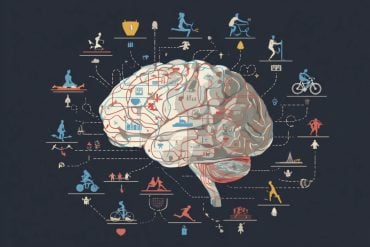Summary: Researchers report an ancient area of the midbrain in all vertebrates can independently control and reorientate the eyes.
Source: Karolinska Institute.
An ancient area of the midbrain of all vertebrates called the corpora quadrigemina can independently contol and reorientate the eyes, researchers from Karolinska Institutet report in a study published in the journal eLIFE.
There is much going on around us all the time, phenomena that we perceive with our different senses, which send information to the brain. When we walk along the street, for example, we encounter other people that we have to avoid bumping into, or might find our attention drawn to an unexpected object. The brain then has the very difficult task of determining which of these multifarious events we need to respond to.
This problem is solved by an ancient part of the midbrain called the corpora quadrigemina, or tectum. This area is found in all vertebrates and contains a complex network of neurons that control the movements of the head and eyes. Information from different parts of the retina project onto different parts of the tectum creating a retina-based map that reflects the information sent by the retina.
“You could say there’s a spatial sensory map in the tectum, where images from the eye are projected to create signals about where things happen,” says Professor Sten Grillner at Karolinska Institutet’s Department of Neuroscience.
Different parts of the retinal map can then activate nerve cells that control motor centres for eye and head movements in the brain stem. When a movement is triggered, other parts of the tectum network are disabled and thus other movements of the eyes and head.
The study also shows that if an event is registered by two senses (e.g. vision and hearing) from the same point the signals will be merged. If two senses thus supply the tectum with contradictory information, the neurons will become less active, thus reducing the likelihood of a triggered physical event such as eye-movement.

The study was conducted on the lamprey, a small, eel-like fish that represents the earliest form of vertebrate, by Sten Grillner along with visiting researchers Andreas Kardamakis and Juan Pérez-Fernández.
“It’s more primitive than normal fish, but important parts of its nerve system share all their basic features with the more advanced nerve systems of mammals,” says Professor Grillner.
Although the study was basic research, it can help scientists understand certain clinical phenomena, such as the morbid impairment of ocular movements caused by Parkinson’s disease.
Funding: The study was financed by the Swedish Research Council, KI’s Research Funds, EU FP7 and StratNeuro.
Source: Christina Sumners – Karolinska Institute
Image Source: This NeuroscienceNews.com image is credited to the researchers/eLife.
Original Research: Full open access research for “Spatiotemporal interplay between multisensory excitation and recruited inhibition in the lamprey optic tectum” by Andreas Kardamakis, Juan Pérez-Fernández and Sten Grillner in eLife. Published online September 16 2016 doi:10.7554/eLife.16472
[cbtabs][cbtab title=”MLA”]Karolinska Institute. “Ancient Brain Area Controls Eye Movements.” NeuroscienceNews. NeuroscienceNews, 21 September 2016.
<https://neurosciencenews.com/eye-movement-midbrain-5097/>.[/cbtab][cbtab title=”APA”]Karolinska Institute. (2016, September 21). Ancient Brain Area Controls Eye Movements. NeuroscienceNews. Retrieved September 21, 2016 from https://neurosciencenews.com/eye-movement-midbrain-5097/[/cbtab][cbtab title=”Chicago”]Karolinska Institute. “Ancient Brain Area Controls Eye Movements.” https://neurosciencenews.com/eye-movement-midbrain-5097/ (accessed September 21, 2016).[/cbtab][/cbtabs]
Abstract
Spatiotemporal interplay between multisensory excitation and recruited inhibition in the lamprey optic tectum
Animals integrate the different senses to facilitate event-detection for navigation in their environment. In vertebrates, the optic tectum (superior colliculus) commands gaze shifts by synaptic integration of different sensory modalities. Recent works suggest that tectum can elaborate gaze reorientation commands on its own, rather than merely acting as a relay from upstream/forebrain circuits to downstream premotor centers. We show that tectal circuits can perform multisensory computations independently and, hence, configure final motor commands. Single tectal neurons receive converging visual and electrosensory inputs, as investigated in the lamprey – a phylogenetically conserved vertebrate. When these two sensory inputs overlap in space and time, response enhancement of output neurons occurs locally in the tectum, whereas surrounding areas and temporally misaligned inputs are inhibited. Retinal and electrosensory afferents elicit local monosynaptic excitation, quickly followed by inhibition via recruitment of GABAergic interneurons. Multisensory inputs can thus regulate event-detection within tectum through local inhibition without forebrain control.
“Spatiotemporal interplay between multisensory excitation and recruited inhibition in the lamprey optic tectum” by Andreas Kardamakis, Juan Pérez-Fernández and Sten Grillner in eLife. Published online September 16 2016 doi:10.7554/eLife.16472






